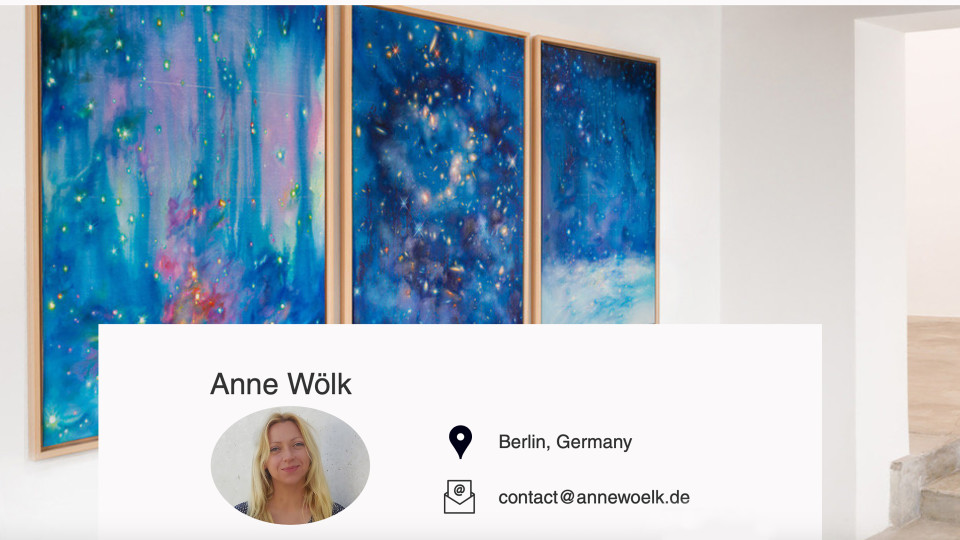07.04.2021, Limelight Artist of the month, Artourney Award, Rotterdam
https://www.artourney.com/projects/anne-wölk
Who is Anne and what does she do?
I was born and raised in former East Germany and I’m a figurative painter whose artistic work stands in the tradition of realistic contemporary artists Vija Celmins and Russel Crotty. Committed to an attitude of reskilling, this landscape painter uses traditional methods and materials.
I develop my compositions from a perspective of observations of the sky and paints a wide variety of light phenomena. My painting process is an artistic translation of terms such as glow and shine into a visual language. For that reason, I work on an unusual and finely nuanced palette of blue shades. The colour spectrum of the light in her paintings astonishes viewers and takes them away to a world of romance and silence.
In this context, my subject matter speaks of the imagery of futuristic science and astronomy, which we have only become familiar with from the advances of satellites, cameras, and computer-generated images. By layering content from these diverse sources, I create a fantastical interpretation of nature, in which the simultaneity of Romanticism and Utopia becomes perceptible.
What is your background?
Being an artist always had great value in my family. Even as a little girl, I did colour pencil drawings with my grandfather. He was incredibly good at drawing men’s heads. His family came originally from East Prussian Königsberg, modern-day Kaliningrad. He knew a lot about the East’s landscapes, with its birch trees and the Baltic region’s coastal formations. While living in East Germany, I regularly studied artworks from Polish landscape painters. I still love the paintings Moose Fighting with Wolves by Julian Fałat (1853–1929), The Old Town Square in Warsaw at Night 1892 by Józef Pankiewicz (1866–1940), and Courtship by Wacław Szymanowski (1859–1930).
At the age of 13, I visited an open house exhibition at the Burg Giebichenstein Art Academy in Halle for the first time in my life. I immediately fell in love with the old castle ruins and the rose garden in the middle of the castle courtyard. It appeared to me like an ivory tower in a kind of nutshell compared to a grey and often hectic urban world.
At that time, I already decided to study art. The moment I turned 16 years old, I tried to apply to art school and was immediately accepted into the painting class of Ute Pleuger.
After three years of studying in this sheltered environment, I felt the need to see a little more of the art world. I moved to the University of Fine Arts Berlin-Weissensee and the Chelsea College of Fine Art and Design, London.
In 2006, I found my first gallery representation in Berlin and exhibited at my first Art Fair called Contemporary Istanbul. On this occasion, Can Elgiz purchased one of my large-scale paintings into the Elgiz Museum collection.
From this point on, I expanded my exhibition activity at an international level, with various group shows in the USA, Great Britain, Spain, Denmark, Slovenia, Turkey, and many other countries.
What does art mean to you?
My paintings predominantly show night sky sceneries with deep and open galaxies. By quoting space telescope images and digital photography resources, I test the margins between art and reality.
With my motives, I try to close the photographic information gaps, like digital error glitches. Simultaneously, I sample landscape compositions in a collage technique to envision a future that’s not here yet.
For me, the process of painting is nothing destructive anymore. Instead, I experience myself as a creator of atmospheres and universes.
I understand the profession of a visual artist as something which brings new thinking and generosity to the world. Therefore I try to be someone who does human work that changes another life for the better.
That includes becoming an innovator in my artistic field of landscape painting. I wish to present discoveries that the audience might have missed. For instance, I replace the deep light of the old masters with screen colours from backlit screen surfaces and attempt to carry the classic themes of the landscapes into the present and future.
read more at Artourney Award, Rotterdam:

